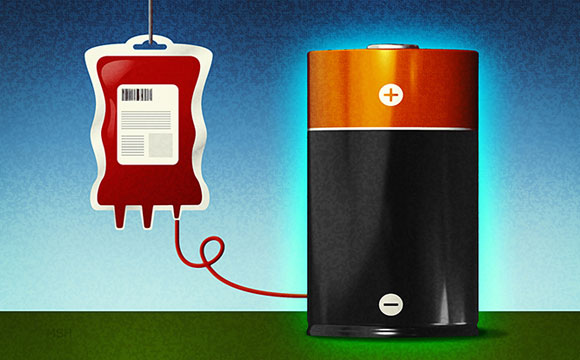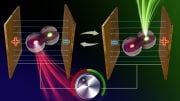
A blood oxygen-transporting molecule may hold the key to creating the next generation of batteries.
New research from Yale University shows that a molecule that transports oxygen in blood could be key to developing the next generation of batteries.
Lithium-oxygen (Li-O2) batteries have emerged in recent years as a possible successor to lithium-ion batteries — the industry standard for consumer electronics — due to their potential for holding a charge for a very long time. Electronic devices would go for weeks without charging, for instance; electric cars could travel four to five times longer than the current standard.
But before this could happen, researchers need to make the Li-O2 batteries efficient enough for commercial application and prevent the formation of lithium peroxide, a solid precipitate that covers the surface of the batteries’ oxygen electrodes. One obstacle is finding a catalyst that efficiently facilitates a process known as oxygen evolution reaction, in which lithium oxide products decompose back into lithium ions and oxygen gas.
The Yale lab of Andre Taylor, associate professor of chemical and environmental engineering, has identified a molecule known as heme that could function as a better catalyst. The researchers demonstrated that the heme molecule improved the Li-O2 cell function by lowering the amount of energy required to improve the battery’s charge/discharge cycle times.
The results appear in Nature Communications. The lead author is Won-Hee Ryu, a former postdoctoral researcher in Taylor’s lab, who is now an assistant professor of chemical and biological engineering at Sookmyung Women’s University in South Korea.
The heme is a molecule that makes up one of the two parts of hemoglobin, which carries oxygen in the blood of animals. Used in a Li-O2 battery, Ryu explained, the molecule would dissolve into the battery’s electrolytes and act as what’s known as a redox mediator, which lowers the energy barrier required for the electrochemical reaction to take place.
“When you breathe in air, the heme molecule absorbs oxygen from the air to your lungs and when you exhale, it transports carbon dioxide back out,” Taylor said. “So it has a good binding with oxygen, and we saw this as a way to enhance these promising lithium-air batteries.”
The researchers added that their discovery could help reduce the amount of animal waste disposal.
“We’re using a biomolecule that traditionally is just wasted,” said Taylor. “In the animal products industry, they have to figure out some way to dispose of the blood. Here, we can take the heme molecules from these waste products and use it for renewable energy storage.”
Ryu noted that by using recyclable biowaste as a catalyst material, the technology is both effective and could be preferential in developing green energy applications.
Reference: “Heme biomolecule as redox mediator and oxygen shuttle for efficient charging of lithium-oxygen batteries” by Won-Hee Ryu, Forrest S. Gittleson, Julianne M. Thomsen, Jinyang Li, Mark J. Schwab, Gary W. Brudvig and André D. Taylor, 19 October 2016, Nature Communications.
DOI: 10.1038/ncomms12925









Be the first to comment on "Heme Molecule May Be The Key To More Effficient Batteries"